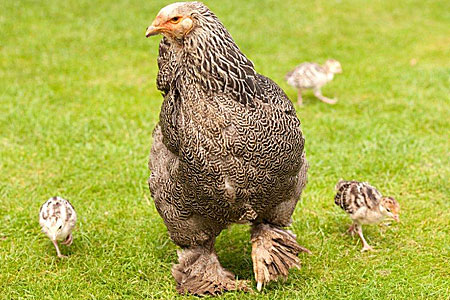
A setting hen doesn’t know (or doesn’t care) whether or not the eggs she hatches are her own. Under natural conditions her nest may consist of a collection of eggs from various hens in the flock. So, you might deliberately use your broody chicken hens as foster moms to hatch eggs laid by other hens, even of another species. Or you might slip recently hatched chicks under her. An advantage to using a calm hen to brood a typically flighty breed or species is that the young ones will grow up to be a little less flighty.
Egg Size
When a heavy weight chicken is expected to hatch eggs that are much smaller than her own, she could end up crushing the eggs. So, size does matter.
If the eggs are much larger than her own — such as turkey or goose eggs — a small hen might have trouble turning them adequately. To ensure a successful hatch, pitch in and turn them for her.
The most critical time to turn eggs is during the first week of incubation. Mark each egg with an X on one side and an O on the opposite side. Turn the eggs three times a day. At one turning, all the Xs should show. Next time turn up all the Os. Always make sure the pointy end of the egg is oriented downward.
Another aspect of asking a hen to hatch larger eggs is that they result in larger hatchlings that typically grow fast. So be prepared for the brood to soon surpass their “mom” in size, especially if she’s a Silkie or other bantam hatching non-bantam eggs.
Incubation Period
Eggs hatch at different rates for different breeds and species. To combine eggs that differ in incubation period, schedule them to all hatch at the same time. You might, for example, add chicken eggs to guinea eggs after the hen has been setting on them for 7 days.
When asking a chicken to hatch eggs that take longer than 21 days, use only a proven broody hen. A hen that’s brooding for the first time may not be willing to continue long enough to hatch eggs that take more than 21 days.
Foster Chicks
Often a hen can be enticed to raise chicks she didn’t hatch herself. She is most likely to accept foster chicks if she’s been seriously setting for several days. Signs that she may be ready to accept chicks are consistently remaining on the nest, clucking, and puffing up when disturbed.
The hatchlings should be not much more than a day old, while they’re still receptive to accepting (or imprinting) a new mom. To increase the chances both parties will accept each other, slip the babies under the hen at night. In the event things don’t work out as you had planned, be prepared to retrieve them and brood them yourself.
You can sometimes induce a hen to raise a brood even if she hasn’t been setting, especially if she’s proven in the past to be a reliable broody. Put the hen and chicks together in a secluded and dimly lit brooding pen and watch for the four typical signs the hen is willing to care for the chicks. Not necessarily in this order, a hen is likely to accept chicks when:
- She clucks loudly and continuously.
- She spreads her wings to cover the chicks.
- She rushes to assist any chick making distress sounds.
- She tidbits — clucking rapidly while picking up and dropping bits of food.
Extra Chicks
Since a hen can successfully mother as many as three times the number of chicks she can hatch herself, you might add newly hatched chicks to your hen’s brood. This ploy works best if all the chicks are the same age. As always, slip the extra, recently hatched chicks under the hen at night. If you’re moving the hen and her brood from the nesting site to a brooding pen, place all the chicks in the pen first so they mix together before you introduce the hen.
And that’s today’s news from the Cackle Coop.
Gail Damerow is the author of Hatching and Brooding Your Own Chicks: Chickens, Turkeys, Ducks, Geese, Guinea Fowl.

